Exploring Stone Shapes in Ring Design
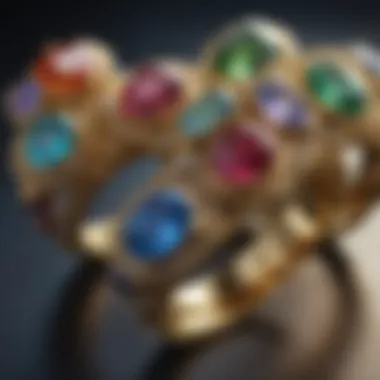
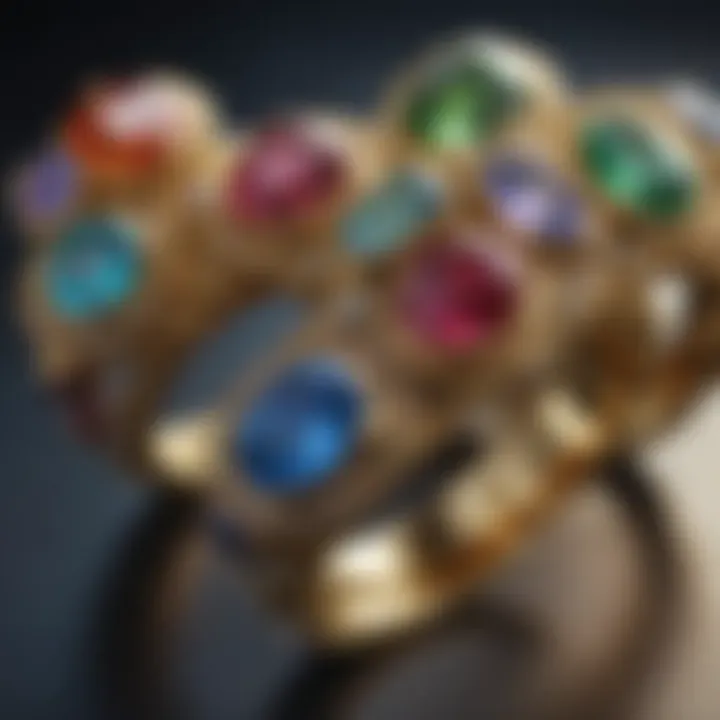
Intro
In the quest for the perfect ring, the stone shape plays a pivotal role in defining the piece's character and appeal. Whether it’s a dazzling diamond or a vibrant emerald, the geometry of the gemstone significantly influences both aesthetics and personal style. This exploration offers an in-depth look at the different shapes available, revealing their individual merits and how they tie into cultural meanings and personal preferences. By the end of this comprehensive guide, both enthusiasts and potential buyers will find themselves equipped with the knowledge needed to make informed choices regarding stone shapes in rings.
Gemstone Overview
Definition and Origins
Gemstones, viewed as nature's artwork, are precious stones prized for their beauty and rarity. Typically, they arise from mineral compounds subjected to various geological processes over millions of years. These stones, when cut and polished, transform into striking pieces suitable for adornment. In the realm of ring design, the shape of a stone can evoke different emotions or convey specific messages, making it an essential consideration for buyers.
Historical Significance
The shapes utilized in gemstone rings have historical roots that trace back to ancient civilizations. For instance, the round cut, known for its classic look, has its origins in ancient Egypt, where jewelry represented wealth and power. Over time, different cultures adopted their own styles. For instance, the marquise cut was designed to honor the beauty of the French court. Each shape carries a piece of history, reflecting the tastes and values of its era.
"A stone's cut can be a window into its past, revealing not just its physical properties but also the tales of societies and cultures that cherished it."
Gemstone Properties
Hardness and Durability
Among the key properties of gemstones, hardness stands out prominently. Measured on the Mohs scale, which ranges from 1 (talc) to 10 (diamond), a stone’s hardness influences its durability in everyday wear. Rings, being exposed to constant friction and impacts, necessitate stones with higher ratings for prolonged wear.
- Diamond: 10
- Sapphire: 9
- Ruby: 9
- Emerald: 7.5 to 8
Rings featuring softer stones, such as opal or turquoise, may require more caution to avoid scratches or chips. Therefore, considerations of hardness and the stone's setting become crucial in selecting a durable piece.
Color and Clarity
The color and clarity of a gemstone can profoundly affect its appeal and market value. The color encompasses not just the hue, but also the intensity and saturation of that color. Meanwhile, clarity pertains to the presence of internal inclusions that can diminish a stone’s brilliance or visual purity.
- Colors like deep blue or vibrant green often fetch higher prices due to their popularity.
- Clarity grades from 'included' to 'flawless' provide a range of options for those seeking quality in their selection.
Choosing a stone shape involves more than just selecting a pretty piece; it is a journey through history, culture, and personal expression. As we delve further into various shapes, we will uncover how their unique features align with different styles, occasions, and individual narratives.
Intro to Stone Shapes for Rings
When it comes to rings, particularly engagement and wedding bands, the choices are as vast as the ocean. But, the shape of the stone set in that ring holds more weight than many realize. It’s not just about aesthetics; it’s about the story it tells, the emotions it embodies, and the significance it carries. Whether you’re a romantic at heart or a staunch minimalist, understanding the nuances of stone shapes can enhance your selection process, making it both personal and meaningful.
The Relevance of Stone Shapes
Stone shapes dictate not only the look of a ring but also its style and, to an extent, its wearability. Picture a round cut stone sitting atop a delicate band compared to a bold emerald cut—these two convey entirely different impressions. A ring isn't just jewelry; it often symbolizes deep commitment or celebrates memorable life events. The right shape can echo sentiments, from classic elegance to adventurous charm.
Moreover, stone shapes can influence how light interacts with the gem. For instance, a round cut often maximizes brilliance due to its multiple facets, creating a sparkling effect that catches everyone's attention. Meanwhile, an Asscher cut, with its vintage vibe, may appeal to those who appreciate subtlety over flamboyance.
Benefits of Understanding Stone Shapes
Knowing the various stone shapes can arm potential buyers with the ability to:
- Align Personal Style: A person's choice in stone shape reveals their personality. For example, a heart-shaped gem may suit a romantic individual, while a more geometric cut might favor someone with modern tastes.
- Make Educated Decisions: When purchasing a ring, understanding the characteristics of stone shapes allows for informed choices, ensuring satisfaction long after the sale is complete.
- Evoke Emotion: Each shape carries its own connotation. A marquise cut, known for its unique silhouette, can evoke a sense of rarity and flair.
- Custom Fit: Armed with knowledge about stone shapes, buyers can venture into custom designs, blending unique features that reflect their story.
"The choice of a stone shape should feel intuitive, like it was meant to be from the start."
In summary, the importance of understanding stone shapes extends beyond basic knowledge, impacting design, emotion, and personal style. Embracing this knowledge equips us to choose rings that resonate both visually and emotionally. By focusing on this critical aspect, the article aims to illuminate the decisions that can be made while selecting rings for life's significant moments.
Understanding the Importance of Stone Shapes
The shapes of stones used in rings play a pivotal role in their overall appeal and significance. They are not just a matter of personal preference; they embody a wide range of emotional and aesthetic values that resonate with wearers. Understanding the importance of stone shapes can enhance the decision-making process for prospective buyers and jewelry designers alike, providing insight into how these shapes impact functionality, design, and cultural expression.
When someone selects a ring, the stone shape is usually one of the first things they notice. The intrigue of a well-cut gem doesn’t just lie in its sparkle; it’s also about how the shapes align with personal tastes and styles.
Aesthetics and Design Impact
Different shapes have unique aesthetics. For example, round cut stones are famous for their brilliance and timeless appeal. Their circular shape allows light to reflect in a certain way, maximizing sparkle and allure. In contrast, a princess cut stone offers a modern flair, boasting sharp, clean lines that appeal to those with a contemporary sensibility.
The design impact goes beyond mere looks. The shape influences how the stone is set in the ring, which can further accentuate its characteristics. For instance:
- Prong settings can elevate the stone, presenting it in a way that showcases its luster.
- Bezel settings wrap around the stone, offering a more understated elegance while providing protection.
Thus, selecting a stone shape isn't merely about style; it’s a consideration of how the ring will interact with a person's lifestyle and aesthetic preferences.
Cultural Significance
Cultural implications also underpin the significance of stone shapes. Shapes often represent different meanings across cultures. For instance, heart-shaped stones convey romance, making them a popular choice for engagement rings. In contrast, oval and marquise cuts can symbolize elegance and prosperity, drawing from historical uses in fine jewelry.
This cultural layering imbues the ring with personal and communal significance. As trends evolve, so do the meanings associated with various shapes. When an individual chooses a particular stone shape, they are engaging with a broader narrative that transcends their personal story, tapping into a rich tapestry of history and significance.
"The shape of the stone can tell a story that goes beyond its physical presence; it connects the wearer to a history shared across cultures."
In summary, understanding the importance of stone shapes ties directly into the aesthetic, practical, and cultural aspects of the ring. As one navigates through the various options, it becomes apparent that the shape is more than just a representation of taste—it's a multifaceted choice with implications on beauty, meaning, and identity.
Classic Stone Shapes
Classic stone shapes have stood the test of time, remaining a staple in the jewelry world due to their enduring beauty and symbolic significance. These shapes not only define the aesthetics of a ring but also speak to the wearer's personality and style. Understanding the intricacies of classic cuts helps buyers choose wisely, ensuring that each piece reflects their taste and values. In this section, we will delve deeper into three widely celebrated cuts: Round Cut, Princess Cut, and Emerald Cut stones, each with its distinct charm and set of attributes that influence their desirability.
Round Cut Stones
The Round Cut is arguably the most sought-after shape in the realm of gemstones. With its impeccable symmetry and brilliance, it captures light beautifully, resulting in a dazzling display of sparkle. Typically, this shape has 58 facets that enhance its scintillation, making it highly appealing for engagement rings and other fine jewelry.
This shape is versatile and complements various ring settings, from solitaires to more intricate designs. When choosing a round cut stone, potential buyers often consider the Four Cs: Cut, Clarity, Color, and Carat weight. Additionally, the round cut is often associated with romance and timelessness, further solidifying its popularity among couples.
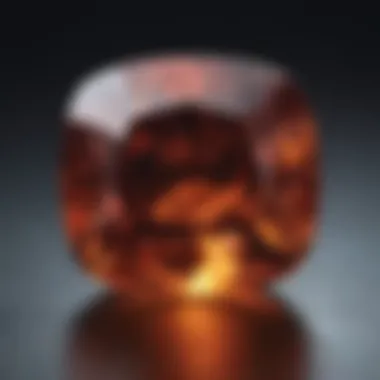
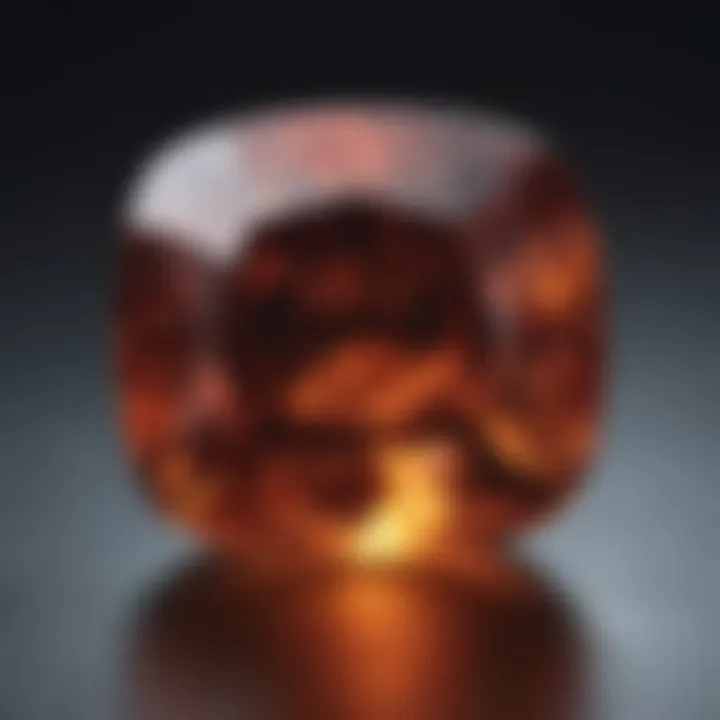
- Light Performance: Precision cuts allow for optimal light returns.
- Versatility: Suits a range of styles and settings.
- Symbolism: Represents eternity due to its circular form.
"The Round Cut stones have a perfect blend of brilliance and tradition, appealing to generations of buyers."
Princess Cut Stones
Next on our list is the Princess Cut stones, renowned for their modern appeal and sophisticated charm. This square or rectangular cut has gained immense popularity since the 1970s, often chosen for its balance between contemporary style and classic elegance. With sharp lines and a chic silhouette, the Princess Cut stone offers a mesmerizing play of light while maintaining a striking presence.
This type of cut typically has 76 facets, enhancing its brilliance and overall visual impact. Those who opt for Princess Cut stones often appreciate their unique edges and angles, which add a touch of modernity while still honoring timeless design principles. The Princess Cut often aligns with personal styles that are bold yet refined, appealing to both fashion-forward thinkers and those who prefer a mix of old and new.
- Modern Look: Appeals to contemporary tastes.
- Brilliant Sparkle: Facets create a dazzling effect.
- Ideal for Various Settings: Works well in both sleek and ornate settings.
Emerald Cut Stones
Emerald Cut stones offer a different kind of elegance, showcasing a more subdued, rectangular form with long, sweeping facets. This cut is often considered timeless, embodying sophistication and grace. Unlike the sparkling brilliance of Round and Princess cuts, the Emerald Cut is known for its understated beauty, prioritizing clarity and color over flash.
The step cut style, featuring fewer facets (usually around 50), provides a unique allure that highlights the gemstone’s inherent qualities. When one looks at an Emerald Cut stone, they invite the eye to explore its depth and character, making it a favored choice for those who appreciate quality over quantity in terms of sparkle.
- Sophisticated Appeal: Highly coveted by those with a taste for luxury.
- Showcases Color and Clarity: Ideal for high-quality stones.
- Distinctive Design: Stands out from the more common cuts.
Contemporary Stone Shapes
In the world of ring design, contemporary stone shapes play a pivotal role. They reflect current trends and resonate with modern aesthetics, offering a refreshed take on how a gemstone can be perceived. While traditional cuts maintain their charm, modern shapes appeal to those looking for something unique, making them increasingly relevant in today's jewelry market. For gemstone enthusiasts, collectors, and designers, understanding contemporary shapes is essential. The beauty lies not only in their look but also in the emotions and statements they convey.
Cushion Cut Stones
The cushion cut combines a vintage appeal with a modern touch, which makes it versatile for various styles of rings. Named for its soft and rounded sides resembling a pillow, this cut features larger facets that enhance light reflection. Wider and deeper than the typical round cut, cushion cut stones can create a striking glow, capturing attention while maintaining a sense of elegance.
- Ideal for both engagement rings and statement pieces.
- Works beautifully with both colored and clear gemstones.
- The unique shape allows for creative settings, from vintage-inspired to contemporary designs.
"Cushion cuts are often favored by those who appreciate a touch of classic elegance with a modern twist."
Asscher Cut Stones
Asscher cut stones distinguish themselves with their octagonal shape and deep pavillion facets. Often likened to an emerald cut, the key difference is in the striking symmetry and distinct play of light that an Asscher stone provides. Its square shape offers a vintage allure that's hard to resist, becoming increasingly popular among those who seek both sophistication and character in a ring.
- Provides a unique personality to the jewelry piece.
- Suitable for both vintage and modern ring designs.
- The cut's depth allows for a mesmerizing optical effect, enhancing the overall appearance of the gemstone.
Oval Cut Stones
Oval cut stones strike a beautiful balance between traditional and contemporary styles. With an elongated silhouette, they appear larger than their round counterparts of the same carat weight. An oval cut is both feminine and robust, making it a popular choice for various ring styles. This shape embraces versatility and complement various settings, empowering the wearer with a sense of individuality.
- Enhances brilliance, thanks to its longer facets.
- Perfect for both simple band settings and elaborate design styles.
- Creates an illusion of length, flattering on the hand.
Understanding these contemporary stone shapes not only enriches the design possibilities but also offers insight into personal preferences. Each cut brings a distinct personality to the jewelry, reflecting both the wearer’s taste and the trends of the moment. As tastes evolve and individuality becomes paramount, navigating these modern designs becomes crucial for anyone passionate about gemstones.
Unique and Specialty Stone Shapes
In the vast realm of gemstone rings, unique and specialty stone shapes stand out for their individuality and character. These shapes often capture the imagination of jewelry enthusiasts due to their less conventional forms and the bold statements they make. Opting for a distinct shape is not just about aesthetics; it reflects personal taste and can carry significant emotional value. These stone shapes often serve as conversation starters, showcasing the wearer’s unique perspective and approach to style.
When considering a ring, many might default to the classic shapes, but exploring unique stone shapes can be quite rewarding. They tend to break the mold, allowing for creativity and personal expression. Being on the fringe of traditional might raise eyebrows, but for those seeking to express their identity, these shapes can truly resonate. The craftsmanship involved in creating rings with unique stones is remarkable. Each shape not only provides a different visual appeal but also influences the setting style and overall design of the piece.
Another important consideration is how these unique shapes can symbolize various meanings or intentions. For instance, the choice of a particular shape can convey messages such as love, admiration, or even commitment, going beyond mere visual aesthetics.
Marquise Cut Stones
The marquise cut, with its elongated shape and pointed ends, is reminiscent of a small boat. Popularized during the reign of King Louis XV, it was originally commissioned to resemble the lips of his mistress. This shape is particularly striking because it creates the illusion of a larger stone, making it an attractive choice for those who desire sparkle without a hefty price tag.
One of the advantages of selecting a marquise cut is that it tends to elongate the appearance of the fingers, an effect cherished by many wearers. The playful facets reflect light beautifully, creating a dazzling display that can captivate anyone's attention.
"The marquise cut not only enhances a stone’s size appearance but exhibits a luminous brilliance unmatched by many other cuts."
Trilliant Cut Stones
Trilliant cut stones, also known as triangular cut stones, offer a contemporary flair with their crisp edges and unique angles. This shape allows for remarkable light refraction, leading to a vibrant play of colors. The modern appeal of trilliant stones makes them a fascinating choice for those looking to deviate from tradition.
Choosing a trilliant cut can reflect an adventurous spirit, often associated with a bold personality. They're often used as side stones or in unique settings to create eye-catching contrast. It’s a shape that encourages creativity in design, making each piece truly one-of-a-kind.
Heart-Shaped Stones
Heart-shaped stones, the quintessential symbol of love, hold a special place in the hearts of many. Not just a pretty face, they encapsulate emotions like commitment and romance. The rounded edges and pointed tip provide a unique silhouette that can be both delicate and striking, making them a popular choice for engagement rings and gifts.
When selecting a heart-shaped stone, proper crafting is essential. The quality of the cut will determine how well the stone sparkles and how effectively it conveys that emotional message. Due to its shape, settings must be particularly skillfully done to showcase the heart without compromising its integrity or elegance.
Materials Used for Ring Stones
Understanding the materials that constitute the stones in rings offers insight not only into their aesthetics but also into their emotional significance and durability. Selecting the right material can be a game changer when it comes to both the appearance and longevity of a piece of jewelry. Different materials possess unique properties, catering to varied preferences and lifestyles. In this section, we will examine the two primary classifications of materials used for ring stones: precious gemstones and semi-precious stones.
Precious Gemstones
Precious gemstones often represent the pinnacle of luxury in the realm of jewelry. Historically, these stones have been valued for their rarity, beauty, and the enduring elegance they bring to any piece. Precious stones commonly include diamonds, rubies, sapphires, and emeralds. Each of these stones carries its own distinctive traits, appealing to a wide range of personal tastes.
- Diamonds: Renowned for their brilliance and hardness. We often hear the saying, "A diamond is forever," which speaks to its lasting power.
- Rubies: Their deep red color represents love and passion. Often used in engagement rings, they symbolize enduring relationships.
- Sapphires: While blue is the most recognized color, these stones come in a variety of hues. Associated with wisdom and nobility, sapphires are a classic choice for a refined look.
- Emeralds: Known for their captivating green shade, emeralds are often linked to rebirth and fertility, adding a layer of meaning to their beauty.
Choosing a precious gemstone can elevate a ring's design, serving as its centerpiece and often determining its value. However, with great value comes great responsibility, as these stones generally require careful maintenance and protection.
"The selection of a stone goes beyond mere preference; it's a reflection of one's values, style, and aspirations."
Semi-Precious Stones
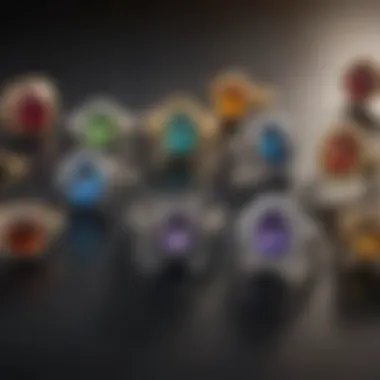
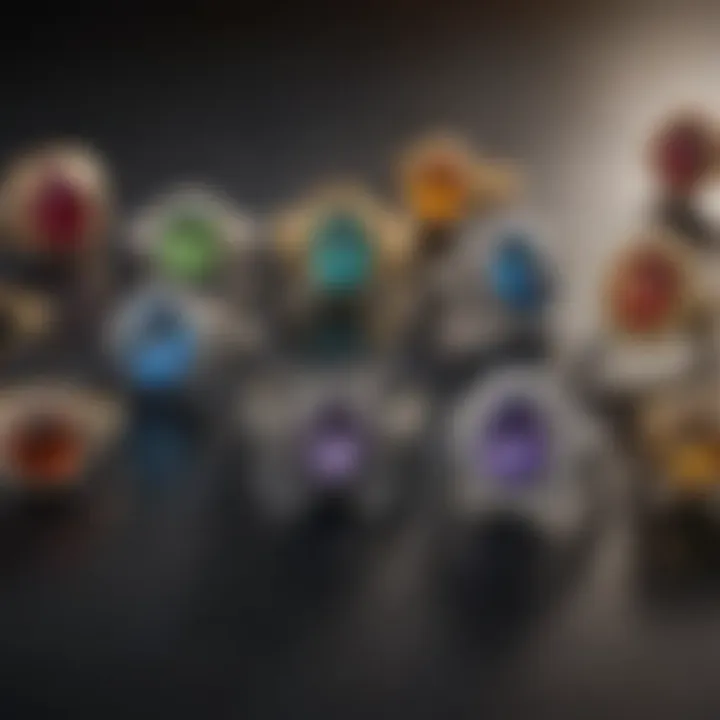
On the other hand, semi-precious stones open up a more extensive palette of colors and choices for ring designs. Generally, they are more plentiful than precious stones, providing a budget-friendly alternative without compromising on style or uniqueness. Popular semi-precious stones include amethyst, garnet, aquamarine, and topaz.
- Amethyst: This purple stone is often associated with tranquility and balance. Many choose it for a more whimsical and vibrant look.
- Garnet: Known for its rich, red tones, garnets are believed to signify friendship and trust, often a popular choice for tokens of love and affection.
- Aquamarine: With its serene blue hue, aquamarine is linked to natural beauty and fluidity, making it an appealing stone for summer weddings.
- Topaz: This versatile stone comes in various colors. It symbolizes love and affection, resonating well in rings focused on personal connections.
The allure of semi-precious stones lies in their variety and affordability. They allow for customization and creative expression, making it easy for anyone to find a fitting stone that resonates with their style and storyline.
In summary, the choice between precious and semi-precious stones is not just about value or quality. Each material tells its own tale, illuminating personal meanings, aesthetics, and even lifestyles. With greater knowledge of the materials at hand, potential buyers and enthusiasts can make informed decisions that reflect their taste and values.
The Intersection of Design and Functionality
In the multifaceted realm of jewelry design, particularly regarding rings, understanding the intersection of design and functionality is crucial. It's not just about creating something that looks good on the outside; functionality ties into how the design works with the lifestyle of the wearer. A beautiful ring can quickly turn into a source of frustration if it doesn't fit the user's daily life.
Choosing the Right Shape for Lifestyle
When selecting a stone shape for a ring, one must consider the day-to-day activities of the wearer. For instance, someone who leads an active lifestyle may find that a lower profile design minimizes the risk of the stone catching on clothing or bumping against hard surfaces. Shapes such as a round cut or princess cut, known for their streamlined form, tend to provide a snug fit that complements such a lifestyle.
Conversely, if someone tends to favor outdoor adventures or has a job that involves manual labor, a bezel setting—where the stone is encased in metal—could offer more protection than a prong setting. This design encapsulates the stone, securing it against potential damage while still allowing it to shine.
In essence, the right shape speaks to both personal expression and practical needs. One should weigh the balance between aesthetics and the day-to-day demands of life.
Durability and Maintenance Considerations
Durability of the stone shape can’t be overlooked in the grand scheme of things. Certain cuts defy wear over time better than others. For instance, the brilliant round cut shines beautifully but can be more vulnerable than shapes like the marquise cut, which might distribute force more evenly due to its pointed edges.
When it comes to maintenance, some shapes are easier to clean than others. A cushion cut or an oval cut might hide dirt effectively within their facets, requiring regular cleaning to maintain their luster. On the flip side, a princess cut offers sharp corners that can accumulate grime, necessitating frequent cleaning to avoid dullness.
"Choosing a stone for preservation is as important as selecting it for its beauty; after all, you want your statement ring to withstand the test of time."
In summary, the conversation surrounding the intersection of design and functionality is vital for anyone investing in a ring. Style choices should reflect one’s personality and abide by the rituals of life, while durability and maintenance ensure that the ring remains a point of joy rather than a concern. Properly considering these factors not only enhances the experience of wearing a ring but also deepens the appreciation for the craftsmanship involved.
Setting Styles for Different Shapes
When it comes to designing a ring, the way a stone is set can significantly influence how it looks and feels. Each setting style not only enhances the beauty of the stone but also serves practical functions. Hence, selecting the appropriate setting style for a specific stone shape is crucial in creating a successful jewelry piece. Factors such as the stone’s form, the wearer's lifestyle, and personal style preferences should all be considered. The right setting can elevate a piece from simple to stunning, providing both security and flair.
Prong Settings
Prong settings are one of the most traditional and common styles used in ring designs, particularly for those more round-cut stones. In this setting, small metal claws or prongs are used to secure the stone in place. This design allows for maximum exposure of the gemstone.
Benefits of Prong Settings:
- Enhanced Sparkle: Less metal blocks light, leading to a greater brilliance of the stone.
- Versatility: Works well with various stone shapes, from round to princess cut.
- Easier Cleaning: Minimal metal means it’s simpler to keep the stone clean.
However, it's essential to note that prong settings might not be ideal for everyone since they expose the stone more than other settings, making it susceptible to chips or damage if not cared for properly. For active wearers, a lower profile prong setting can be beneficial.
Bezel Settings
In contrast to prong settings, bezel settings encapsulate the stone entirely. A strip of metal wraps around the edge of the gemstone, securing it snugly. This setting offers different advantages, especially for those looking for durability and a contemporary flair.
Benefits of Bezel Settings:
- Increased Security: The stone is less likely to fall out or get damaged because it’s surrounded by metal.
- Modern Look: Bezel settings lend a sleeker, more modern aesthetic to the piece.
- Customizability: Jewelers can easily craft bezels in various shapes and sizes, making it suitable for irregular stones as well.
Bezel settings can also help emphasize the unique shape of certain stones, particularly those that are less traditional. However, they can slightly hide the stone's facets, reducing its light reflection.
Pavé Settings
Pavé settings present a different charm, as they create a sparkling surface through the use of tiny gemstones set closely together. While this style can be used with various shapes of stones, it is particularly popular for adding extra shimmer around a central piece, serving as a beautiful border.
Benefits of Pavé Settings:
- Extra Sparkle: Lots of small stones create impressive shine and help draw attention.
- Unique Design Opportunities: Allows for stunning visual contrasts between larger center stones and the smaller surrounding gems.
- Low Profile: Because the stones sit flush with the band, there’s less risk of them catching on clothing or other items.
Nevertheless, pavé settings may require meticulous maintenance and cleaning as dirt can easily accumulate in the tiny crevices.
Overall, selecting the appropriate setting style for different stone shapes plays a pivotal role in both the aesthetics and functionality of rings. Each option, whether prong, bezel, or pavé, has its own strengths, and understanding these can lead to educated choices for any jewelry enthusiast.
Choosing the Right Shape for Engagement Rings
Choosing the right shape for engagement rings is no mere trivial pursuit; it can make all the difference between a piece that delights and one that feels lackluster. Rings are often more than just adornments—they embody significant moments and emotions. Thus, selecting the right stone shape is essential in transmitting those feelings effectively.
When contemplating an engagement ring, one must reckon not just with aesthetics, but also with personal preference and cultural implications. The right shape can enhance the stone’s brilliance, size, and how it catches light. Ultimately, this decision influences how the ring will be perceived both by the wearer and by onlookers.
Traditional vs. Modern Trends
Traditional shapes, such as the round brilliant or princess cuts, have stood the test of time for their classic beauty and universal appeal. These shapes tend to project a timelessness—something many couples cherish as they embark on their life together.
Conversely, modern trends have introduced a plethora of unique shapes that veer away from the conventional. Shapes like the oval cut, pear shape, or even more contemporary options like the marquise provide a breath of fresh air. They often reflect the individual style of the wearer, showcasing not only their personality but also their relationship’s distinct narrative.
Benefits of Traditional Shapes:
- Timelessness: Remains in style regardless of the era.
- Brilliance: Cut for maximum light reflection and sparkle.
Benefits of Modern Shapes:
- Uniqueness: Offers a personalized touch to signify individuality.
- Visual Illusion: Certain shapes can make stones appear larger without a bigger price tag.
"The shape you choose can say more about your relationship than you might think."
Understanding the interplay between these two paths—tradition and modernity—can guide individuals in making a decision that not only aligns with their tastes but encapsulates their love story.
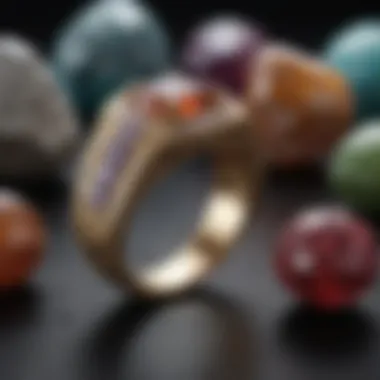
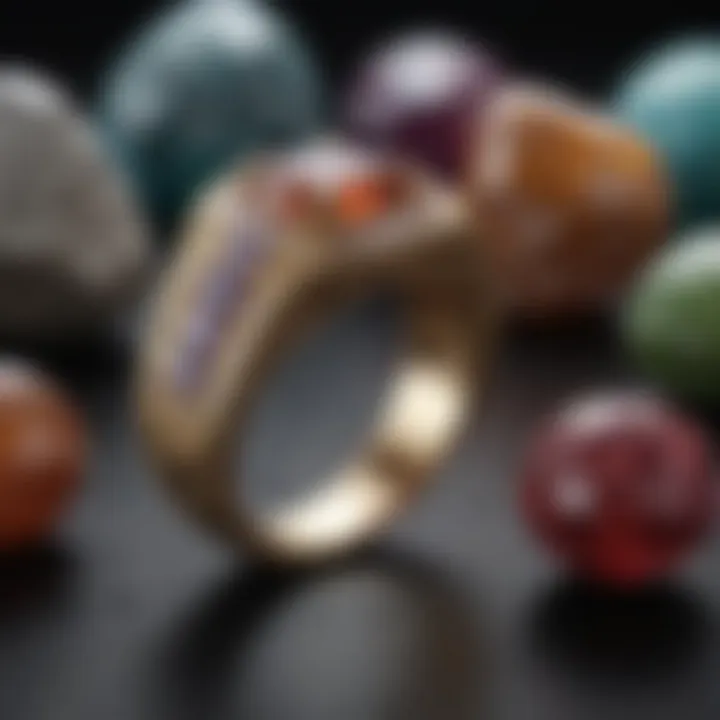
Considerations for Personal Style
Personal style plays a critical role in deciding on the right engagement ring shape. Each person's aesthetics tell a story, and this story is mirrored in their choice of jewelry. When selecting a ring, it’s essential to consider not only how that ring will appear on the finger but also how well it fits into the wearer’s everyday wardrobe and lifestyle.
Factors to Consider:
- Lifestyle: For active individuals, shapes that are less prone to snagging and damage may be preferable.
- Wardrobe Compatibility: A ring should complement the wearer's style rather than clash with it. Someone who favors vintage clothing might lean towards a more intricate cut, while a minimalist may appreciate a sleek and simple design.
- Symbolism: Some prefer rings with shapes that carry specific meanings, such as a heart-shaped stone for romance, while others may desire a more abstract symbol that represents individuality.
The right choice will cater not just to current trends but also to the personal journey that each couple represents. Each shape brings with it a myriad of stories, emotions, and values—a chance to communicate love in its purest form.
Affordability and Value of Different Stone Shapes
When it comes to selecting a stone for a ring, affordability and value loom large. These factors are not just about the price tag; they intertwine with personal choices, aesthetic preferences, and long-term investments. Understanding the financial scope of different stone shapes helps the buyer make informed decisions without losing sight of what they truly want.
Market Variability
The gemstone market is akin to a chameleon, constantly shifting in terms of prices and popularity. This variability can be influenced by numerous factors such as:
- Rarity: Some shapes, like marquise or asscher cuts, might be more difficult to find in certain stones, driving up their value.
- Trends: Every few years, certain stone shapes can become fashionable, influencing demand. For instance, cushion cuts saw a surge in popularity after their association with vintage designs, affecting prices across the board.
- Quality of the Stone: The clarity, color, and cut quality all play a role in pricing. A well-cut round stone of good clarity will typically command a higher price than an irregularly shaped semi-precious gem, irrespective of the shape.
The marketplace is where buyers need to tread carefully. It’s a good idea to keep an ear to the ground regarding the latest trends, while also checking industry reports or resources like Wikipedia and Britannica for updates on market shifts.
Investing in Quality
Investing in quality is paramount, especially in the realm of gemstone rings. Here are several pointers to consider that dive into the significance of choosing well-made pieces:
- Long-term Value: Rings with high-quality stones tend to maintain or even increase in their value over time. Well-crafted pieces are less likely to suffer from damage or depletion in aesthetic appeal compared to less expensive alternatives.
- Craftsmanship: The setting and overall design heavily influence a stone's longevity. A sturdy, well-designed prong setting can protect the stone effectively, ensuring it shines bright for years. The choice of materials also matters; solid gold or platinum settings tend to last longer than their cheaper counterparts.
- Personal Satisfaction: Ultimately, a quality piece is more fulfilling. A ring that you can cherish and enjoy without constant worry about its durability or aesthetic fades is, without a doubt, worth the investment.
"A wise person once said, "Quality over quantity." This couldn't be truer when searching for that perfect ring."
Choosing wisely, especially in a fluctuating market, can ensure not only that the piece is beautiful but also that it holds its value and significance over time. Buyers should embrace a discerning eye and draw a balance between what fits their budget and what they genuinely desire in terms of beauty and longevity.
Personalizing Your Ring
Personalizing a ring goes beyond just selecting a stone shape; it infuses meaning and individuality into what is often a significant piece of jewelry. This process allows people to express their style, commemorate important moments, and connect with sentimental values. The importance of personalizing your ring in this context cannot be overstated. Each decision made reflects not only aesthetic preferences but also emotional significance.
When it comes to personalized rings, a multitude of elements can be tailor-made to suit personal tastes. Here are some key considerations and benefits:
- Unique Expression: Choosing a custom design lets you break away from the mainstream trends, presenting a one-of-a-kind creation.
- Symbolism: Incorporating specific shapes or designs can represent personal narratives or milestones, making the ring deeply meaningful.
- Quality: Opting for custom designs often means working closely with artisans who emphasize quality and craftsmanship.
In essence, personalizing your ring transforms it from a mere accessory into a cherished item that tells your story. This intricate relationship between the design and the wearer is what makes a personalized ring so invaluable.
Custom Designs and Shapes
Diving deeper into custom designs, the essence of this topic revolves around the freedom to choose everything from the stone shape to the setting. Each selected aspect can significantly influence the final piece. When designing a ring, various elements come into play:
- Stone Shapes: The choice of shape greatly influences not only the look but also the overall feel of the ring. For example, a round cut might give a classic appeal, while an emerald cut could lend an air of sophistication.
- Metals Used: The setting might be gold, silver, or even platinum, which can further define the piece's character.
- Size and Proportions: Custom designs allow the flexibility to adjust dimensions, ensuring a perfect fit while maintaining aesthetic balance.
The interplay of these factors culminates in a design that is a true reflection of individuality. Plus, working directly with a jeweler allows for consultations about how your envisioned design can align with what’s practical, stunning, and durable.
Incorporating Symbols and Meanings
Beyond shapes and sizes, the opportunity to weave personal symbols and meanings into the design can elevate the significance of your ring. It’s not just about wearing jewelry; it’s about wearing a piece that resonates with who you are.
Many individuals choose to incorporate symbols that tell their stories or reflect their beliefs. This could involve:
- Birthstones: Using stones that represent significant dates like birthdays or anniversaries not only personalizes the ring but also carries emotional weight.
- Shapes and Motifs: Some people opt for shapes that symbolize love, unity, or a personal creed. Hearts, circles, or even custom icons can imbue the ring with deeper meaning.
- Engravings: A simple phrase, date, or even initials can be engraved to personalize the ring even further. It’s a small touch that can pack a powerful punch in terms of emotional significance.
Incorporating symbols transforms a ring into a personal artifact that can be shared across generations. A well-thought-out design, rich with meaning and intention, can transcend its physical form, ultimately becoming a cherished heirloom.
Caring for Ring Stones
Caring for ring stones is not just a matter of preserving their physical appearance; it goes beyond to emphasize the emotional and monetary values attached to them. Each ring, especially those adorned with carefully chosen stones, carries profound significance for the wearer. To maintain that significance, taking proper care of these stones is paramount. This section aims to shed light on the essential practices that contribute to the longevity and brilliance of your ring stones. Understanding how to care for these gems ensures they continue to sparkle and serve as delightful symbols of love, commitment, or personal achievement.
Cleaning and Maintenance Tips
When it comes to cleaning ring stones, the approach depends largely on the material and the shape of the stone. Here are some practical tips:
- Gentleness is Key: Always opt for a soft cloth to wipe down your ring after wearing it. This helps remove oils, dirt, and any residue that could dull the stone's shine.
- Soapy Solution: For a deeper clean, mix warm water with a mild soap. Using a soft brush (like a toothbrush), gently scrub the stone and its setting, but be cautious with soft stones, as they can scratch easily.
- Professional Cleaning: If the ring is particularly intricate or valuable, consider having it professionally cleaned every so often. Jewelers possess the tools and expertise to clean without causing any harm.
"Regular care not only keeps your ring looking its best but also allows you to make the most of its beauty every day."
In addition to cleaning, maintenance includes being aware of the settings and stones used. Some stones might need special attention, like avoiding exposure to harsh chemicals found in cleaning products or even certain lotions and perfumes. When taking care of softer stones, such as opals or pearls, they require a bit more caution. It's crucial to keep such rings away from areas where they might get bumped or scratched.
Storage Recommendations
Proper storage plays a significant role in maintaining the integrity of your ring stones. Here are some suggestions:
- Separate Compartments: Ideally, store rings in a jewelry box with individual slots. This prevents them from knocking against each other, which could lead to scratches or damage.
- Use Anti-Tarnish Cloth: For silver rings or those that tarnish easily, wrapping them in an anti-tarnish cloth or placing them in an anti-tarnish pouch can preserve their luster longer.
- Avoid Humidity: Keep your jewelry in a cool, dry place. Humidity can be a foe to many stones, leading to cloudiness or other issues.
Ending and Takeaways
In summing up the intricate aspects of stone shapes for rings, it becomes clear just how much thought and consideration should go into selecting the perfect stone. Each shape, whether it be the traditional round or the more contemporary oval, carries its own unique narrative. These stones are more than mere adornments; they are emblematic of personal stories and often signify the milestones of life.
A key takeaway is the aesthetic impact that different stone shapes can impart. A round cut might radiate timeless elegance, while a heart shape brings a romantic flair. The shape you choose can dramatically alter the look of a ring and how it resonates with the wearer’s style. Form matters not only for looks but also influences how the ring interacts with light, contributing to its brilliance and sparkle.
Furthermore, the cultural significance associated with certain shapes cannot be overlooked. Engagement rings, for example, often highlight a round brilliant cut, deeply tied to societal traditions of romance and commitment. Yet, opting for a unique shape like marquise or cushion cut can set one apart, showcasing individuality.
From a practical standpoint, the information discussed throughout this article emphasizes the importance of marrying shape with lifestyle. Active individuals might lean toward shapes that are less prone to snagging or showing wear, whereas those with a penchant for standout pieces might indulge in intricate designs without much thought to daily wear and tear.
Additionally, considerations regarding ceremony and occasion play a significant role in stone selection. Whether it's for a wedding, an anniversary, or a simple personal gift, understanding which shape aligns with the event's significance is crucial.
Final Thoughts
In closing, making an informed choice about stone shapes combines personal taste with practical realities, adorned with historical and cultural nuances. A ring symbolizes more than its value; it represents a tangible piece of one's story, a celebration of moments gone by and those yet to come. Choosing the right shape is both an art and a science, a balance of emotion and reason that can ultimately enrich the experience of wearing a piece of jewelry. By contemplating the myriad of elements highlighted in this study, you can navigate the rich landscape of ring design, leading to a choice that is as meaningful as it is beautiful.



